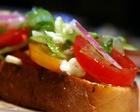|
Italian Appetizer Grilled Bread Slices The lovely bruschetta is so accommodating—it's happy with any number of toppings: goat cheese, chopped roasted peppers, white bean spread. You’re limited only by your imagination. 1 French baguette (any slender loaf) Spread: combine tomatoes in a bowl with 1 T oil, garlic, and vinegar. Add basil, salt and pepper. Cover and place in refrigerator for at least 1 hour, best overnight. Assembly: preheat oven to 375. Slice bread, on a slight diagonal, making 24 or so 1/2" slices. Brush slices with olive oil and place on a cooking sheet. Toast for 8-10 minutes, or until bread begins to turn golden and crispy. Remove from oven and top with tomato mixture. Arrange on a platter and serve immediately. |
Tips & Glossary Arborio Rice: a medium-grained rice. Its high starch content yields a creamy texture and is the basis for risotto. Balsamic Vinegar: dark, thick vinegar with a sweet pungent flavor. Fermented, concentrated, and aged in wooden casks, sometimes up to 12 years. Can be pricey. Caper: salty, pickled bud of spiny shrub native to the Mediterranean region. Most prized is the non-pareil, the smallest (approx. 1/8”), though other sizes are tasty and less expensive. Formaggio: Cheese! Like France, Italy is a land of sublime cheeses, some 400 varieties. Here are some of the most widely sold in the U.S. Italian Seasoning: blend of dried herbs used in Italian cooking—marjoram, thyme, rosemary, savory, sage, oregano, and basil. Packaged commercially and found in most food stores. You can also make your own. Olive Oil: There's much more to know than is room for here. To learn all you need to know about the different grades of oil, and much, much more, head to Tanbourit. Pine Nuts: pinoli or pignoli; edible seeds of pine trees used in pesto sauce. Before cooking, release flavor by lightly browning in a heated skillet. Roasted peppers: buy or make your own: place under a broiler, or hold over a gas flame, till skin chars and blisters. Place in a closed paper bag for 15-20 minutes (to steam them). When cool, the skins slip off under water. Prosciutto: especially Prosciutto di Parma, dry-cured ham from Parma. The real deal! Cured up to 2 years, is almost sweet and very expensive. You can substitute with capicola, a delicious, light peppery ham.
|

